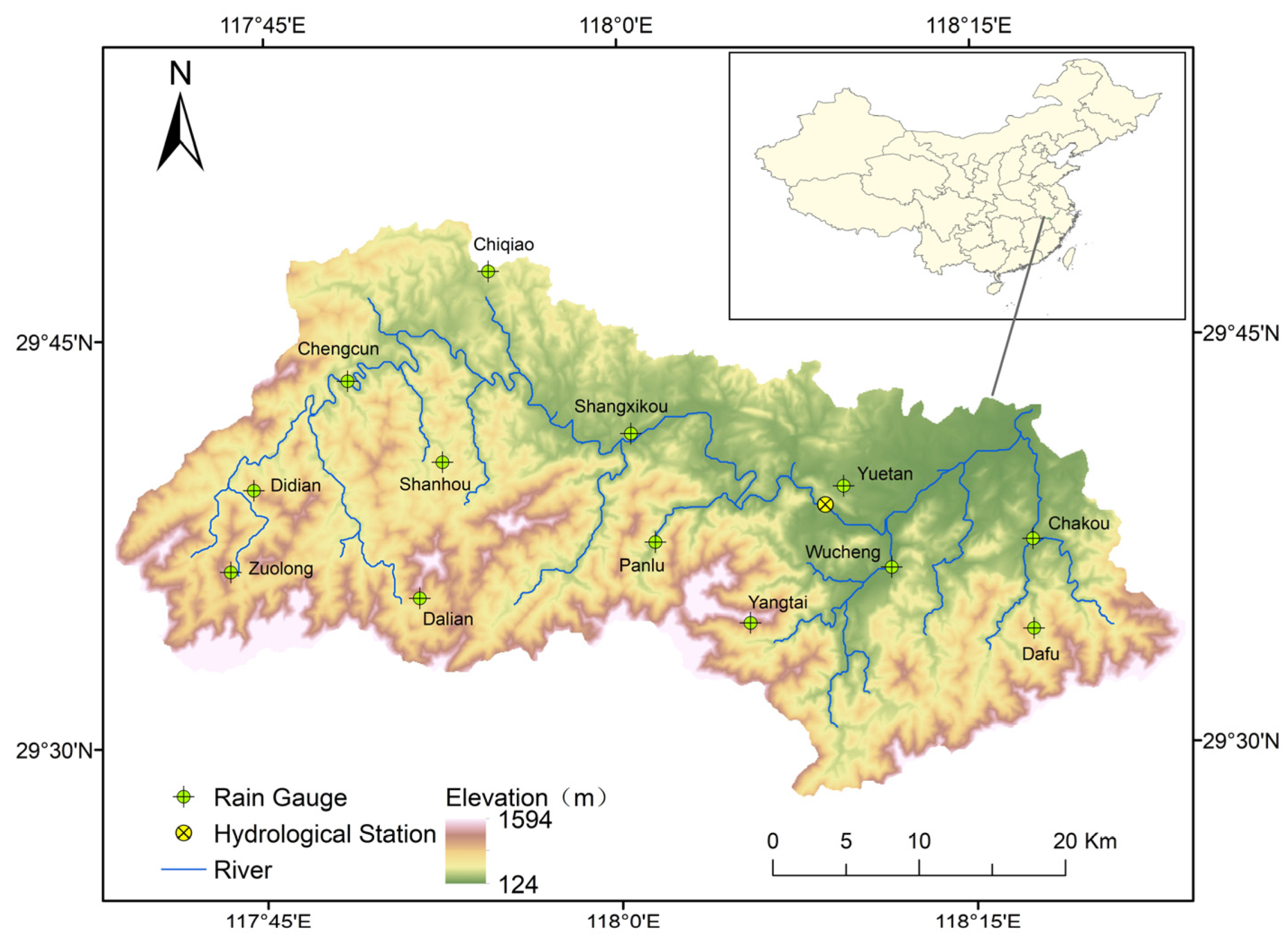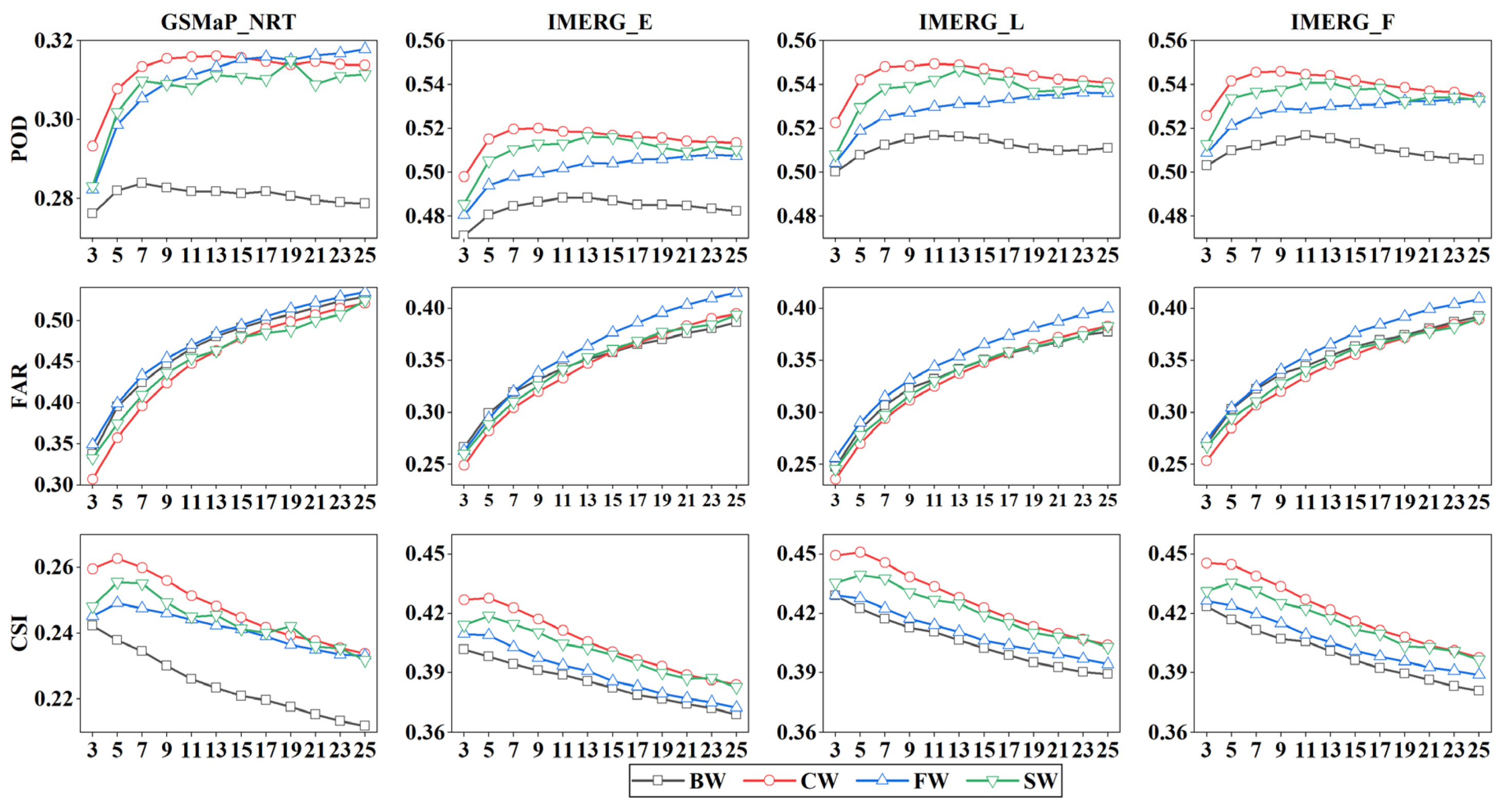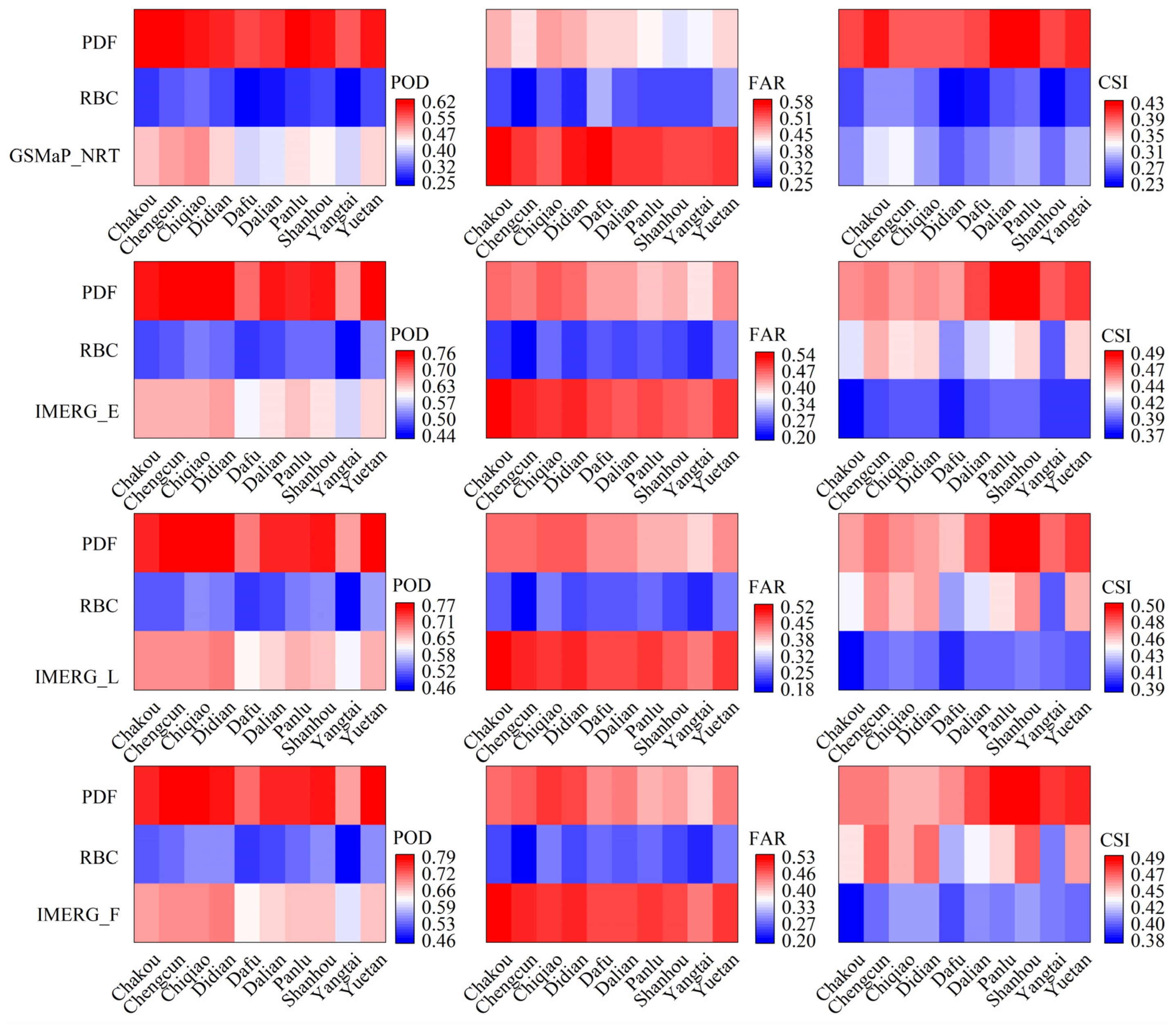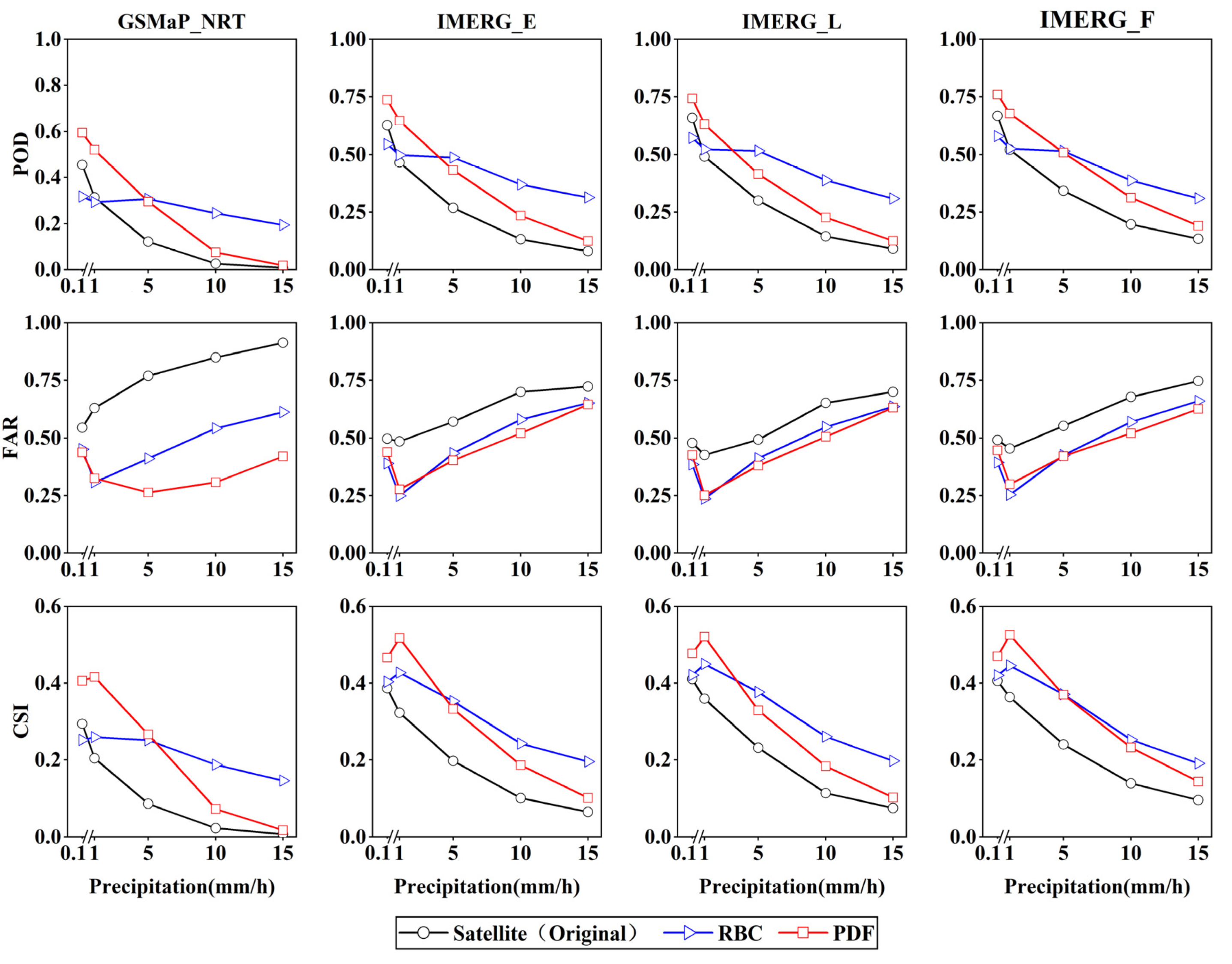Bias Correction of Hourly Satellite Precipitation Products and Their Application in Hydrological Modeling in a Hilly Watershed, China
Abstract
:1. Introduction
2. Materials and Methods
2.1. Study Area
2.2. Data Sources
2.2.1. Satellite Precipitation Products
2.2.2. Meteorological and Hydrological Data
2.2.3. Watershed Characteristics Data
2.3. Assessment of Hourly Satellite Precipitation Products
2.4. Bias Correction of Hourly Satellite Participation Products
2.4.1. Ratio Bias Correction Method
2.4.2. Probability Density Function Matching Method
2.5. Bias Correction Performance Evaluation
2.5.1. Cross-Validation
2.5.2. Hydrological Simulation Evaluation
3. Results and Discussion
3.1. Window Selection in the Ratio Bias Correction
3.2. Comparison of Performance in Correcting the Bias of Hourly Satellite Precipitation Products
3.2.1. Continuous Evaluation Metrics
3.2.2. Categorical Evaluation Metrics
3.3. Hydrological Simulation Evaluation of the Hourly Satellite Precipitation Products
3.3.1. Hydrological Parameter Calibration of the SWAT Models
3.3.2. Comparison of the Hydrological Simulation Results Based on the Hourly Precipitation
4. Conclusions
Author Contributions
Funding
Data Availability Statement
Conflicts of Interest
References
- Wu, P.L.; Christidis, N.; Stott, P. Anthropogenic impact on earth’s hydrological cycle. Nat. Clim. Change 2013, 3, 807–810. [Google Scholar] [CrossRef]
- Allen, M.R.; Ingram, W.J. Constraints on future changes in climate and the hydrologic cycle. Nature 2012, 489, 590. [Google Scholar] [CrossRef]
- Wang, S.; Zhang, L.; Yu, X.; She, D.; Gan, Y. Application of remote sensing precipitation products in runoff simulation over the Lancang River Basin. Resour. Environ. Yangtze Basin 2019, 28, 1365–1374. [Google Scholar]
- Tan, M.L.; Samat, N.; Chan, N.W.; Roy, R. Hydro-Meteorological assessment of three GPM satellite precipitation products in the Kelantan River Basin, Malaysia. Remote Sens. 2018, 10, 1011. [Google Scholar] [CrossRef]
- Darand, M.; Siavashi, Z. An evaluation of Global Satellite Mapping of Precipitation (GSMaP) datasets over Iran. Meteorol. Atmos. Phys. 2021, 133, 911–923. [Google Scholar] [CrossRef]
- Hao, Z.; Tong, K.; Zhang, L.; Duan, X. Applicability analysis of TRMM precipitation estimates in Tibetan plateau. Hydrology 2011, 31, 18–23. [Google Scholar]
- Li, X.; Chen, S.; Liang, Z.; Huang, C.; Li, Z.; Hu, B. Performance assessment of GSMaP and GPM IMERG products during Typhoon Mangkhut. Atmosphere 2021, 12, 134. [Google Scholar] [CrossRef]
- Palomino-Angel, S.; Anaya-Acevedo, J.A.; Botero, B.A. Evaluation of 3B42V7 and IMERG daily-precipitation products for a very high-precipitation region in northwestern South America. Atmos. Res. 2019, 217, 37–48. [Google Scholar] [CrossRef]
- Prakash, S. Performance assessment of CHIRPS, MSWEP, SM2RAIN-CCI, and TMPA precipitation products across India. J. Hydrol. 2019, 571, 50–59. [Google Scholar] [CrossRef]
- Serrat-Capdevila, A.; Merino, M.; Valdes, J.B.; Durcik, M. Evaluation of theperformance of three satellite precipitation products over Africa. Remote Sens. 2016, 8, 836. [Google Scholar] [CrossRef]
- Mou Leong, T.; Santo, H. Comparison of GPM IMERG, TMPA 3B42 and PERSIANN-CDR satellite precipitation products over Malaysia. Atmos. Res. 2018, 202, 63–76. [Google Scholar]
- Navarro, A.; Garcia-Ortega, E.; Merino, A.; Luis Sanchez, J.; Tapiador, F.J. Orographic biases in IMERG precipitation estimates in the Ebro River Basin (Spain): The effects of rain gauge density and altitude. Atmos. Res 2020, 244, 105068. [Google Scholar] [CrossRef]
- Sorooshian, S.; AghaKouchak, A.; Arkin, P.; Eylander, J.; Foufoula-Georgiou, E.; Harmon, R.; Hendrickx, J.M.H.; Imam, B.; Kuligowski, R.; Skahill, B.; et al. Advanced concepts on remote sensing of precipitation at multiple scales. Bull. Am. Meteorol. Soc. 2011, 92, 1353–1357. [Google Scholar] [CrossRef]
- Yu, L.; Ma, L.; Li, H.; Zhang, Y.; Kong, F.; Yang, Y. Assessment of high-resolution satellite rainfall products over a gradually elevating mountainous terrain based on a high-density rain gauge network. Int. J. Remote Sens. 2020, 41, 5620–5644. [Google Scholar] [CrossRef]
- Li, N.; Tang, G.; Zhao, P.; Hong, Y.; Gou, Y.; Yang, K. Statistical assessment and hydrological utility of the latest multi-satellite precipitation analysis IMERG in Ganjiang River Basin. Atmos. Res. 2017, 183, 212–223. [Google Scholar] [CrossRef]
- Li, Q.; Wei, J.; Yin, J.; Qiao, Z.; Peng, W.; Peng, H. Multiscale Comparative evaluation of the GPM and TRMM precipitation products against ground precipitation observations over Chinese Tibetan Plateau. IEEE J. Sel. Top. Appl. Earth Obs. Remote Sens. 2021, 14, 2295–2313. [Google Scholar] [CrossRef]
- Xu, S.; Shen, Y.; Niu, Z. Evaluation of the IMERG version 05B precipitation product and comparison with IMERG version 04A over mainland China at hourly and daily scales. Adv. Space Res. 2019, 63, 2387–2398. [Google Scholar] [CrossRef]
- Yang, X.; Lu, Y.; Tan, M.L.; Li, X.; Wang, G.; He, R. Nine-year systematic evaluation of the GPM and TRMM precipitation products in the Shuaishui River Basin in East-central China. Remote Sens. 2020, 12, 1042. [Google Scholar] [CrossRef]
- Yuan, F.; Zhang, L.; Soe, K.M.W.; Ren, L.; Zhao, C.; Zhu, Y.; Jiang, S.; Liu, Y. Applications of TRMM- and GPM-Era multiple-satellite precipitation products for flood simulations at sub-daily scales in a sparsely gauged watershed in Myanmar. Remote Sens. 2019, 11, 140. [Google Scholar] [CrossRef]
- Lewis, E.; Quinn, N.; Blenkinsop, S.; Fowler, H.J.; Freer, J.; Tanguy, M.; Hitt, O.; Coxon, G.; Bates, P.; Woods, R. A rule based quality control method for hourly rainfall data and a 1 km resolution gridded hourly rainfall dataset for Great Britain: CEH-GEAR1hr. J. Hydrol. 2018, 564, 930–943. [Google Scholar] [CrossRef]
- Meaurio, M.; Zabaleta, A.; Srinivasan, R.; Sauvage, S.; Sanchez-Perez, J.-M.; Lechuga-Crespo, J.L.; Antiguedad, I. Long-term and event-scale sub-daily streamflow and sediment simulation in a small forested catchment. Hydrol. Sci. J. 2021, 66, 862–873. [Google Scholar] [CrossRef]
- Bastola, S.; Misra, V. Sensitivity of hydrological simulations of southeastern United States watersheds to temporal aggregation of rainfall. J. Hydrometeorol. 2013, 14, 1334–1344. [Google Scholar] [CrossRef]
- Li, X.; Huang, S.; He, R.; Wang, G.; Tan, M.L.; Yang, X.; Zheng, Z. Impact of temporal rainfall resolution on daily streamflow simulations in a large-sized river basin. Hydrol. Sci. J. 2020, 65, 2630–2645. [Google Scholar] [CrossRef]
- Cheema, M.J.M.; Bastiaanssen, W.G.M. Local calibration of remotely sensed rainfall from the TRMM satellite for different periods and spatial scales in the Indus Basin. Int. J. Remote Sens. 2012, 33, 2603–2627. [Google Scholar] [CrossRef]
- Manz, B.; Buytaert, W.; Zulkafli, Z.; Lavado, W.; Willems, B.; Alberto Robles, L.; Rodriguez-Sanchez, J.-P. High-resolution satellite-gauge merged precipitation climatologies of the Tropical Andes. J. Geophys. Res. Atmos. 2016, 121, 1190–1207. [Google Scholar] [CrossRef]
- Krajewski, W.F. Cokriging radar-rainfall and rain-gauge data. J. Geophys. Res. Atmos. 1987, 92, 9571–9580. [Google Scholar] [CrossRef]
- Rosenfeld, D. The window probability matching method for rainfall measurements with radar-reply. J. Appl. Meteorol. 1997, 36, 247–249. [Google Scholar] [CrossRef]
- Todini, E. A Bayesian technique for conditioning radar precipitation estimates to rain-gauge measurements. Hydrol. Earth Syst. Sci. 2001, 5, 187–199. [Google Scholar] [CrossRef]
- Shen, Y.; Zhao, P.; Pan, Y.; Yu, J. A high spatiotemporal gauge-satellite merged precipitation analysis over China. J. Geophys. Res. Atmos. 2014, 119, 3063–3075. [Google Scholar] [CrossRef]
- Liu, X.; Yong, Z.; Liu, L.; Chen, T.; Zhou, L.; Li, J. Improving hydrological simulation accuracy through a three-step bias correction method for satellite precipitation products with limited gauge data. Water 2023, 15, 3615. [Google Scholar] [CrossRef]
- Ziarh, G.F.; Shahid, S.; Bin Ismail, T.; Asaduzzaman, M.; Dewan, A. Correcting bias of satellite rainfall data using physical empirical model. Atmos. Res. 2021, 251, 105430. [Google Scholar] [CrossRef]
- Mastrantonas, N.; Bhattacharya, B.; Shibuo, Y.; Rasmy, M.; Espinoza-Davalos, G.; Solomatine, D. Evaluating the benefits of merging near-real-time satellite precipitation products: A case study in the Kinu Basin region, Japan. J. Hydrometeorol. 2019, 20, 1213–1233. [Google Scholar] [CrossRef]
- Deng, P.; Zhang, M.; Bing, J.; Jia, J.; Zhang, D. Evaluation of the GSMaP_Gauge products using rain gauge observations and SWAT model in the upper Hanjiang River Basin. Atmos. Res. 2019, 219, 153–165. [Google Scholar] [CrossRef]
- Kha Dang, D.; Tran Ngoc, A.; Nguyen, N.Y.; Du Duong, B.; Srinivasan, R. Evaluation of grid-based rainfall products and water balances over the Mekong River Basin. Remote Sens. 2020, 12, 1858. [Google Scholar]
- Setti, S.; Maheswaran, R.; Sridhar, V.; Barik, K.K.; Merz, B.; Agarwal, A. Inter-comparison of gauge-based gridded data, reanalysis and satellite precipitation product with an emphasis on hydrological modeling. Atmosphere 2020, 11, 1252. [Google Scholar] [CrossRef]
- Wang, X.; Li, B.; Chen, Y.; Guo, H.; Wang, Y.; Lian, L. Applicability evaluation of multisource satellite precipitation data for hydrological research in arid mountainous areas. Remote Sens. 2020, 12, 2886. [Google Scholar] [CrossRef]
- Mo, C.; Zhang, M.; Ruan, Y.; Qin, J.; Wang, Y.; Sun, G.; Xing, Z. Accuracy analysis of IMERG satellite rainfall data and its application in long-term runoff simulation. Water 2020, 12, 2177. [Google Scholar] [CrossRef]
- Lu, Y.; Tu, J.; Gao, Z.; Li, X.; Yang, S.; Yang, X. Impact of temporal rainfall resolution on SWAT hydrological simulation. China Environ. Sci. 2020, 40, 5383–5390. [Google Scholar]
- Huang, S.; Lu, Y.; Yang, X.; Li, X. Study on spatio-temporal trends of the green development of Huangshan city in Anhui province. Resour. Environ. Yangtze Basin 2019, 28, 1872–1885. [Google Scholar]
- Kubota, T.; Aonashi, K.; Ushio, T.; Shige, S.; Takayabu, Y.N.; Kachi, M.; Arai, Y.; Tashima, T.; Masaki, T.; Kawamoto, N. Global Satellite Mapping of Precipitation (GSMaP) products in the GPM era. In Satellite Precipitation Measurement; Springer: Cham, Switzerland, 2020; Volume 1, pp. 355–373. [Google Scholar]
- Liu, J.; Sun, Z.; Zhang, T.; Cheng, X.; Dong, X.; Tan, X. Hydrological evaluations of runoff simulations based on multiple satellite precipitation products over the Huayuan Catchment. Resour. Environ. Yangtze Basin 2018, 27, 2558–2567. [Google Scholar]
- Habib, E.; Haile, A.T.; Sazib, N.; Zhang, Y.; Rientjes, T. Effect of bias correction of satellite-rainfall estimates on runoff simulations at the source of the upper Blue Nile. Remote Sens. 2014, 6, 6688–6708. [Google Scholar] [CrossRef]
- Ines, A.V.M.; Hansen, J.W. Bias correction of daily GCM rainfall for crop simulation studies. Agric. For. Meteorol. 2006, 138, 44–53. [Google Scholar] [CrossRef]
- Song, W.; Xie, X.; Xu, T.; Wang, C.; Zhou, D. Construction of hydrological processes model and analysis of hydrological functions of marsh wetlands in Honghe region. Wetl. Sci. 2014, 12, 544–551. [Google Scholar]
- Liu, J.; Wei, R.; Zhang, T.; Zhang, Q.; Liu, Y. Spatial and temporal evolution characteristics of dry and wet condition in Yalongjiang River Basin based on the CHIRPS satellite precipitation. Resour. Environ. Yangtze Basin 2020, 29, 1800–1811. [Google Scholar]
- Cui, L.; Wang, S.; Liu, Y.; Jiang, Y.; Dong, L.; Huang, C. Comparative study on downscaling of TRMM and GPM satellite precipitation data in three major river basins in China. Resour. Environ. Yangtze Basin 2021, 30, 1317–1328. [Google Scholar]
- Jiang, S.; Ren, L.; Yong, B.; Yuan, F.; Gong, L.; Yang, X. Hydrological evaluation of the TRMM multi-satellite precipitation estimates over the Mishui Basin. Adv. Water Sci. 2014, 25, 641–649. [Google Scholar]
- Zhang, S.; Yu, P.; Wang, Y.; Zhang, H.; Valentina, K.; Huang, S.; Xiong, W.; Xu, L. Estimation of actual evapotranspiration and its component in the upstream of Jinghe Basin. Acta Geogr. Sin. 2011, 66, 385–395. [Google Scholar]
- Zhou, L.; Rasmy, M.; Takeuchi, K.; Koike, T.; Selvarajah, H.; Ao, T. Adequacy of near real-time satellite precipitation products in driving flood discharge simulation in the Fuji River Basin, Japan. Appl. Sci. 2021, 11, 1087. [Google Scholar] [CrossRef]
- Abbaspour, K.C.; Vejdani, M.; Haghighat, S. SWAT-CUP calibration and uncertainty programs for SWAT. In Proceedings of the International Congress on Modelling and Simulation (MODSIM07), Christchurch, New Zealand, 10–13 December 2007. [Google Scholar]
- Patii, M.; Kothari, M.; Gorantiwar, S.D. Runoff simulation using the SWAT model and SUFI-2 algorithm in Ghod Catchment of upper Bhima River Basin. Indian J. Soil Conserv. 2019, 47, 7–13. [Google Scholar]







| NO. | Name of Station | Latitude | Longitude | Height (m) |
|---|---|---|---|---|
| 1 | Chakou | 29.625° | 118.292° | 164 |
| 2 | Dafu | 29.575° | 118.292° | 339 |
| 3 | Yuetan | 29.658° | 118.158° | 205 |
| 4 | Yangtai | 29.575° | 118.092° | 788 |
| 5 | Panlu | 29.625° | 118.025° | 234 |
| 6 | Chiqiao | 29.792° | 117.908° | 287 |
| 7 | Shanhou | 29.675° | 117.875° | 351 |
| 8 | Dalian | 29.592° | 117.858° | 499 |
| 9 | Chengcun | 29.725° | 117.808° | 258 |
| 10 | Didian | 29.658° | 117.742° | 545 |
| Data | Specification | Source |
|---|---|---|
| Digital elevation model (DEM) | 30 m | Geospatial data cloud |
| Land use and land cover | 1:100,000 | Landsat satellite image interpretation, the second national land survey, statistical yearbook of Xiuning County |
| Soil type and soil properties | 1:1,000,000 | Harmonized World Soil Database (HWSD), Soil Survey of Anhui Province |
| Evaluation Metric | Method | GSMaP_NRT | IMERG_E | IMERG_L | IMERG_F |
|---|---|---|---|---|---|
| CC | Before bias correction | 0.25 | 0.47 | 0.51 | 0.51 |
| RBC | 0.50 | 0.59 | 0.60 | 0.61 | |
| 0.66 | 0.65 | 0.66 | 0.68 | ||
| RMSE (mm) | Before bias correction | 1.74 | 1.57 | 1.51 | 1.56 |
| RBC | 1.49 | 1.52 | 1.47 | 1.46 | |
| 1.27 | 1.24 | 1.24 | 1.23 | ||
| RB (%) | Before bias correction | −32.98 | −22.18 | −25.06 | −10.31 |
| RBC | 48.57 | 14.98 | 14.49 | 12.14 | |
| 36.89 | 13.77 | 17.91 | 2.29 | ||
| MAD (mm) | Before bias correction | 0.38 | 0.33 | 0.31 | 0.33 |
| RBC | 0.30 | 0.28 | 0.27 | 0.27 | |
| 0.26 | 0.25 | 0.24 | 0.25 |
| Parameters | SURLAG | ALPHA_BF | GW_REVAP | GW_DELAY | GWQMN | REVAPMN | CANMX | EPCO | SOL_K | SOL_ AWC | ESCO | CH_K2 | CH_N2 | CH_K1 | CH_N1 |
|---|---|---|---|---|---|---|---|---|---|---|---|---|---|---|---|
| Rainfall station | 11.97 | 0.55 | 0.16 | 19.92 | 194.40 | 195.40 | 37.25 | 0.60 | 1.47 | 0.23 | 0.56 | 16.92 | 0.18 | 6.00 | 23.19 |
| GSMaP_NRT | 19.15 | 0.80 | 0.08 | 1.75 | 200.00 | 246.60 | 37.55 | 0.61 | 2.35 | 0.11 | 0.57 | 12.28 | 0.20 | 76.08 | 20.67 |
| IMERG_E | 23.89 | 0.53 | 0.12 | 3.53 | 56.80 | 257.80 | 20.55 | 0.88 | 1.53 | 0.18 | 0.90 | 32.04 | 0.15 | 61.04 | 14.26 |
| IMERG_L | 19.15 | 0.80 | 0.08 | 1.75 | 200.00 | 246.60 | 37.55 | 0.61 | 1.66 | 0.11 | 0.57 | 12.28 | 0.20 | 76.08 | 20.67 |
| IMERG_F | 20.25 | 0.87 | 0.19 | 5.92 | 133.60 | 125.40 | 38.25 | 0.88 | 1.68 | 0.13 | 0.76 | 22.04 | 0.17 | 26.80 | 20.19 |
| GSMaP_NRT (RBC) | 11.56 | 0.82 | 0.03 | 54.19 | 427.20 | 237.80 | 11.55 | 0.52 | 1.79 | 0.19 | 0.89 | 14.04 | 0.17 | 61.84 | 26.91 |
| IMERG_E (RBC) | 15.84 | 0.63 | 0.08 | 4.13 | 374.40 | 112.60 | 23.15 | 0.72 | 1.72 | 0.11 | 0.62 | 26.28 | 0.14 | 11.44 | 25.05 |
| IMERG_L (RBC) | 20.25 | 0.87 | 0.19 | 5.92 | 133.60 | 125.40 | 38.25 | 0.88 | 2.37 | 0.13 | 0.76 | 22.04 | 0.17 | 26.80 | 20.19 |
| IMERG_F (RBC) | 20.25 | 0.87 | 0.19 | 5.92 | 133.60 | 125.40 | 38.25 | 0.88 | 1.68 | 0.13 | 0.76 | 22.04 | 0.17 | 26.80 | 20.19 |
| GSMaP_NRT (PDF) | 23.89 | 0.53 | 0.12 | 3.53 | 56.80 | 257.80 | 20.55 | 0.88 | 2.16 | 0.18 | 0.90 | 32.04 | 0.15 | 61.04 | 14.26 |
| IMERG_E (PDF) | 20.25 | 0.87 | 0.19 | 5.92 | 133.60 | 125.40 | 38.25 | 0.88 | 2.37 | 0.13 | 0.76 | 22.04 | 0.17 | 26.80 | 20.19 |
| IMERG_L (PDF) | 23.89 | 0.53 | 0.12 | 3.53 | 56.80 | 257.80 | 20.55 | 0.88 | 1.53 | 0.18 | 0.90 | 32.04 | 0.15 | 61.04 | 14.26 |
| IMERG_F (PDF) | 20.25 | 0.87 | 0.19 | 5.92 | 133.60 | 125.40 | 38.25 | 0.88 | 1.68 | 0.13 | 0.76 | 22.04 | 0.17 | 26.80 | 20.19 |
| Precipitation Data | Calibration Period (2010–2013) | Validation Period (2014–2017) | |||||
|---|---|---|---|---|---|---|---|
| R2 | NSE | RB (%) | R2 | NSE | RB (%) | ||
| Rainfall station | 0.92 | 0.91 | −9.36 | 0.91 | 0.91 | −7.79 | |
| GSMaP_NRT | Original | 0.34 | 0.30 | −18.20 | 0.34 | 0.26 | −17.53 |
| RBC | 0.56 | 0.55 | −16.06 | 0.40 | 0.52 | −14.75 | |
| 0.77 | 0.70 | −13.00 | 0.55 | 0.69 | −12.76 | ||
| IMERG_E | Original | 0.74 | 0.73 | −23.66 | 0.66 | 0.71 | −21.73 |
| RBC | 0.84 | 0.82 | −17.37 | 0.86 | 0.80 | −15.96 | |
| 0.86 | 0.84 | −18.83 | 0.85 | 0.83 | −16.49 | ||
| IMERG_L | Original | 0.75 | 0.74 | −18.44 | 0.70 | 0.73 | −16.94 |
| RBC | 0.81 | 0.79 | −16.37 | 0.70 | 0.78 | −15.04 | |
| 0.84 | 0.83 | −12.81 | 0.83 | 0.82 | −10.96 | ||
| IMERG_F | Original | 0.78 | 0.77 | −23.88 | 0.78 | 0.75 | −21.94 |
| RBC | 0.81 | 0.80 | −22.93 | 0.73 | 0.79 | −21.07 | |
| 0.84 | 0.82 | −18.56 | 0.86 | 0.81 | −17.05 | ||
Disclaimer/Publisher’s Note: The statements, opinions and data contained in all publications are solely those of the individual author(s) and contributor(s) and not of MDPI and/or the editor(s). MDPI and/or the editor(s) disclaim responsibility for any injury to people or property resulting from any ideas, methods, instructions or products referred to in the content. |
© 2023 by the authors. Licensee MDPI, Basel, Switzerland. This article is an open access article distributed under the terms and conditions of the Creative Commons Attribution (CC BY) license (https://creativecommons.org/licenses/by/4.0/).
Share and Cite
Ye, J.; Lu, Y.; Yang, X.; He, Z.; Huang, P.; Zheng, X. Bias Correction of Hourly Satellite Precipitation Products and Their Application in Hydrological Modeling in a Hilly Watershed, China. Water 2024, 16, 49. https://doi.org/10.3390/w16010049
Ye J, Lu Y, Yang X, He Z, Huang P, Zheng X. Bias Correction of Hourly Satellite Precipitation Products and Their Application in Hydrological Modeling in a Hilly Watershed, China. Water. 2024; 16(1):49. https://doi.org/10.3390/w16010049
Chicago/Turabian StyleYe, Jinyin, Yang Lu, Xiaoying Yang, Zhixin He, Pengnian Huang, and Xinxin Zheng. 2024. "Bias Correction of Hourly Satellite Precipitation Products and Their Application in Hydrological Modeling in a Hilly Watershed, China" Water 16, no. 1: 49. https://doi.org/10.3390/w16010049
APA StyleYe, J., Lu, Y., Yang, X., He, Z., Huang, P., & Zheng, X. (2024). Bias Correction of Hourly Satellite Precipitation Products and Their Application in Hydrological Modeling in a Hilly Watershed, China. Water, 16(1), 49. https://doi.org/10.3390/w16010049






